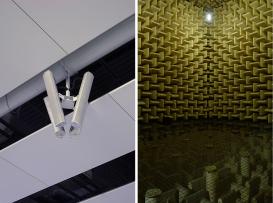What sonic models propagate in anechoic setups? What spatial ontologies and sonic materialities are fostered in echoless surroundings? How do environmentless anechoic practices assert modes of sonic attention that in turn environ the quotidian? This project experimentalized contemporary auditory settings by applying a retroactive hearing to formative anechoic procedures.
Anechoic chambers—specialized echo-dampened facilities where acoustics, electroacoustics, and psychoacoustics have been calibrated since the 1940s—evolved in the historical context of tactical sound propagation and reception in combat situations. The physics of aeronautic vibration, battlefield voice transmission, and communication psychoacoustics intersect at the anechoic chamber, formulating a set of problems in terms of mechanical noise control, speech comprehension, and auditory fatigue respectively. Acoustic norms, psychoacoustic thresholds, and electroacoustic innovations pioneered in the chamber carry over into civilian categories of telecommunication, aviation, architectural technology, and the auto and entertainment industries. Arguably, today, disparate examples of personal and public audio techniques manifest a kind of latent anechoic reverb where the control and formatting of acoustic energy within the chamber produce modes of sound and hearing elsewhere. The “Padded Sounds” project researched particular framings of sonic attention enforced in anechoic practices and followed their haphazard recurrence within the commonplace.

